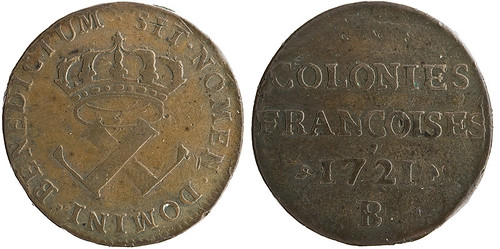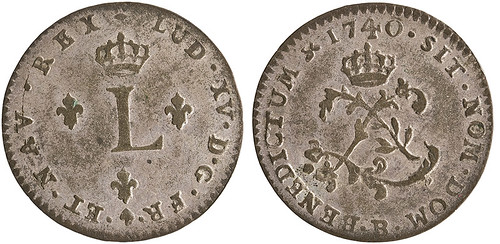
Jérôme Jambu published an American Numismatic Society Pocket Change blog article titled French Coins in America or French American Coins? (and which America?). Here's an excerpt - see the complete article online.
-Editor
As American numismatists and collectors of the colonial period know, it is difficult to differentiate coins of the Kingdom of France sent to America from those produced specifically for this region. It is equally difficult to name these coins, to determine their value, and to attribute them to a specific place. There are two reasons for this: the difficult access of Americans to archives written in French, scattered throughout the country; and the little interest shown by the French people, a large part of whom have forgotten their history in the New World. However, the cross-referencing of available data is necessary to understand these coins and reclassify them, as Sydney F. Martin began (Martin 2015) one hundred years after Ernest Zay (Zay 1892).
A couple of examples can illustrate this problem. First, for more than 300 years, French, Canadian, and American numismatists gave the 5- and 15-sol Gloriam Regni coins (Fig. 1), struck in 1670, to New France (and particularly to Canada) because of an error of attribution by Le Blanc in 1690, always repeated without being interrogated. Although some of these coins had effectively circulated in this area, we are today sure due to the recent discovery of unpublished French documents, that they were created specifically for the French West Indies (Jambu 2021).
Figure 1. 15-sol Gloriam Regni, 1670, Paris, created for French West Indies
(ANS 1967.99.1, where it was classified as Canadian until recently).
The sou or sol marqué reflects another problem. This designation includes a variety of different coins. In France, the nickname marqué was attributed to sols reformed with a countermark in 1640. It was used in the French colonies and today by Americans for several types of sols: those countermarked in 1640, some without countermark, the series produced between 1738 and 1764 (Fig. 2), etc. Furthermore, not one of these coins were created especially for French America—not even the sols reformed in 1640 and those created in 1738, contrary to the opinion expressed by some authors on both sides on the Atlantic. They have just been sent to the colonies, when necessary, like so many other coins. French coins in America are not French American coins.
Figure 2. Sol marqué , 1740, Rouen, created for the French Kingdom
(ANS 1967.99.21, where it was classified as Canadian until recently)
French coins made specifically for American colonies are in truth very few. They are only small coins. The 5- and 15-sol coins dated 1670 were the first in silver, followed only by the 6- and 12-sol coins dated 1731–1732. These second ones clearly show through their legend, Isles du Vent (Windward Islands), they were made for the Lesser West Indies (Fig. 4). Like the previous issue, these were used to break the high-valued piastres with a too-strong purchasing power, and which circulated in abundance. Even though, once again, they may have migrated to other areas, especially because the monarchy had given them a too low price (Jambu forthcoming).
Three other creations are related to copper small change—and they were hardly successful. The 6- and 12-denier coins for the colonies were not made for a long time in Perpignan (1717), due to insufficient material and poor-quality metal. A few were shipped to the continent, in New France. The 9-denier Colonies françoises coins, minted in La Rochelle and Rouen in 1721–1722, are one part of a larger program (Fig. 5): denominations of 4½ and 18 deniers were imagined, as well as produced in Bordeaux and La Rochelle. Canada accepted a few of them, though with distrust. Only Louisiana welcomed them before finally returning some to France a few years later. They were better received in the thirteen British North American colonies…and subsequently in the Indian Ocean French colonies! Finally, the Colonies françoises copper coins from 1767, despite their vague legend, were only intended for Lesser West Indies and immediately refused. Martinique charged them on ships going to France, and Guadeloupe stored these coins, only to counterstamp and use them during the Revolution (1793). Copper coins did not successfully circulate in the Caribbean area, which was accustomed to precious metals, and the continent could hardly be satisfied with it. To understand this, one must keep in mind that French people were particularly mercantilist and bullionist, and abhorred any kind of fiat money, as the State had abused paper money (bills from the Bank of Law in France, card money in Canada).

Figure 5. 9-denier Colonies françoises , 1721, Rouen, created for New France
(ANS 1966.252.17, where it was classified as Canadian until recently)
To read the complete article, see:
French Coins in America or French American Coins? (and which America?)
(https://numismatics.org/pocketchange/jambu/)
Wayne Homren, Editor
The Numismatic Bibliomania Society is a non-profit organization
promoting numismatic literature. See our web site at coinbooks.org.
To submit items for publication in The E-Sylum, write to the Editor
at this address: whomren@gmail.com
To subscribe go to: https://my.binhost.com/lists/listinfo/esylum
Copyright © 1998 - 2024 The Numismatic Bibliomania Society (NBS)
All Rights Reserved.
NBS Home Page
Contact the NBS webmaster
|





